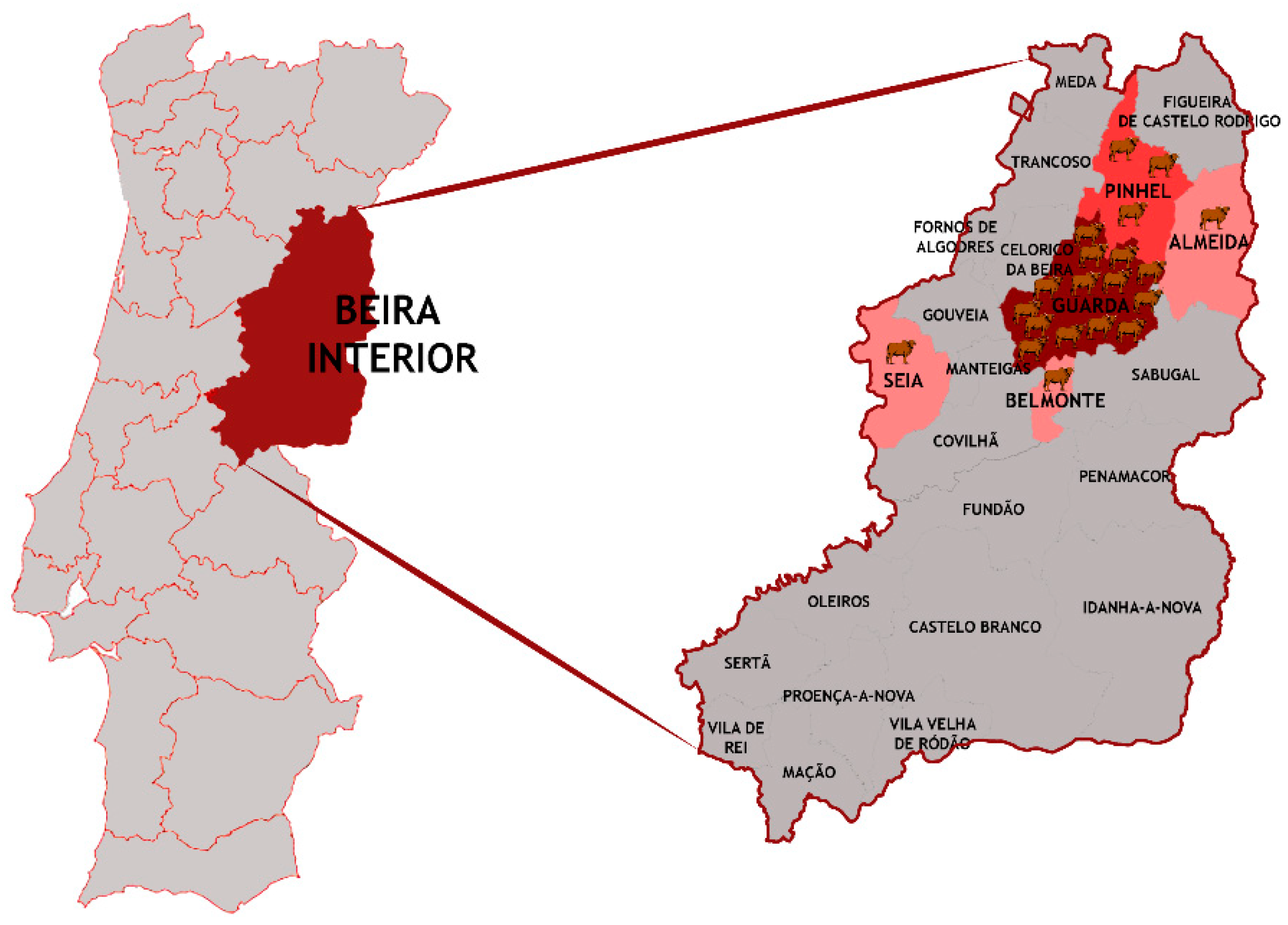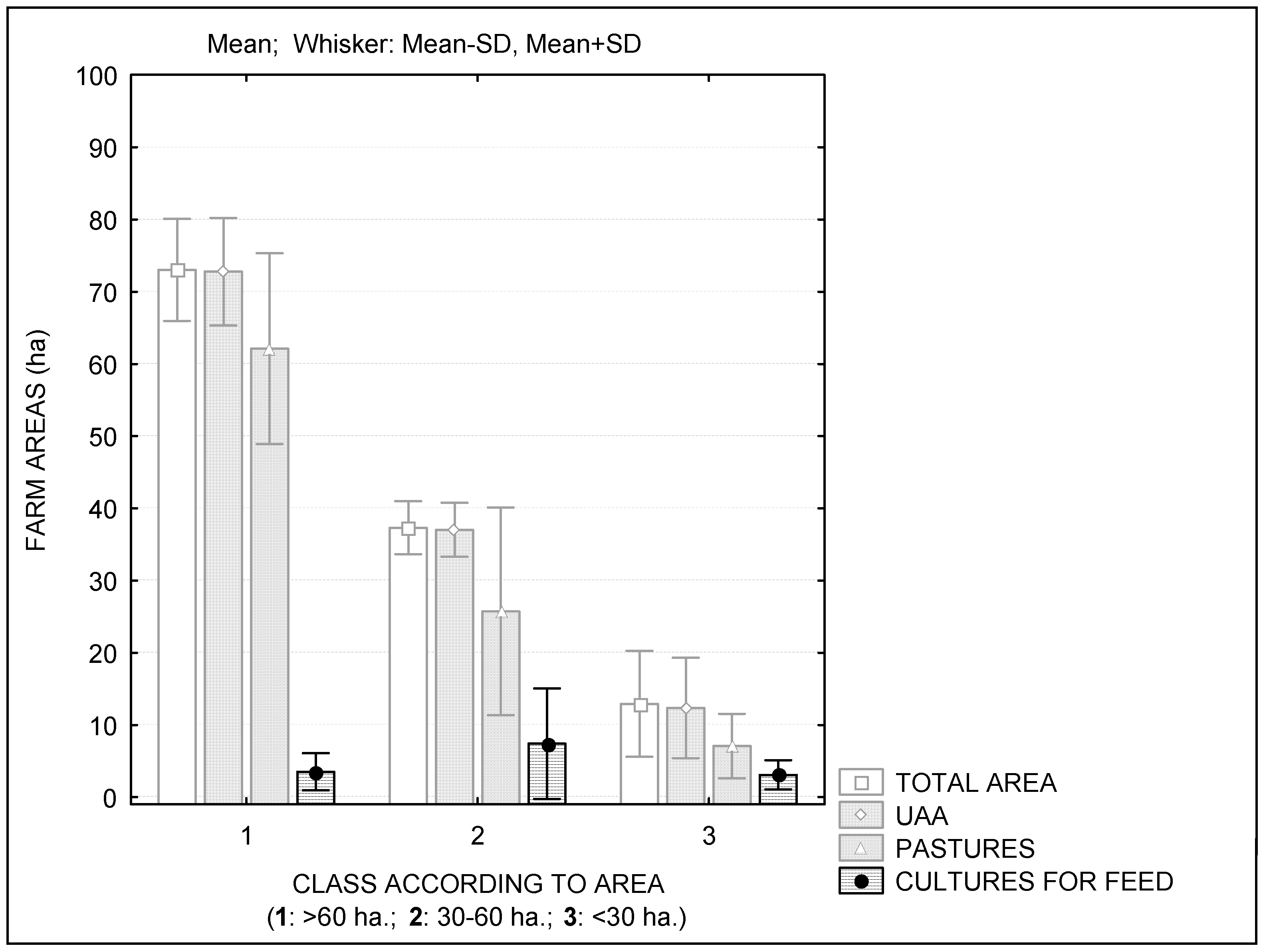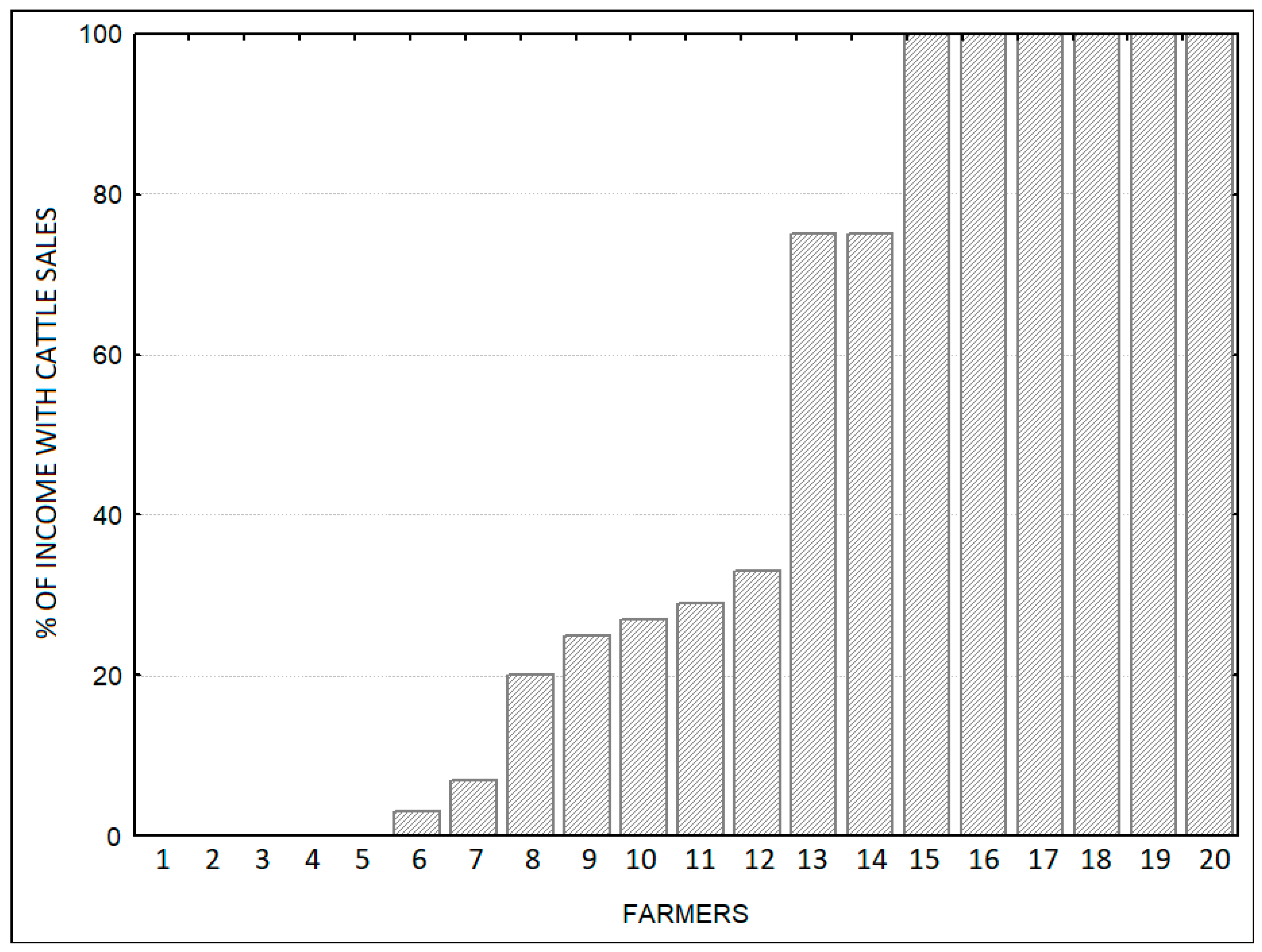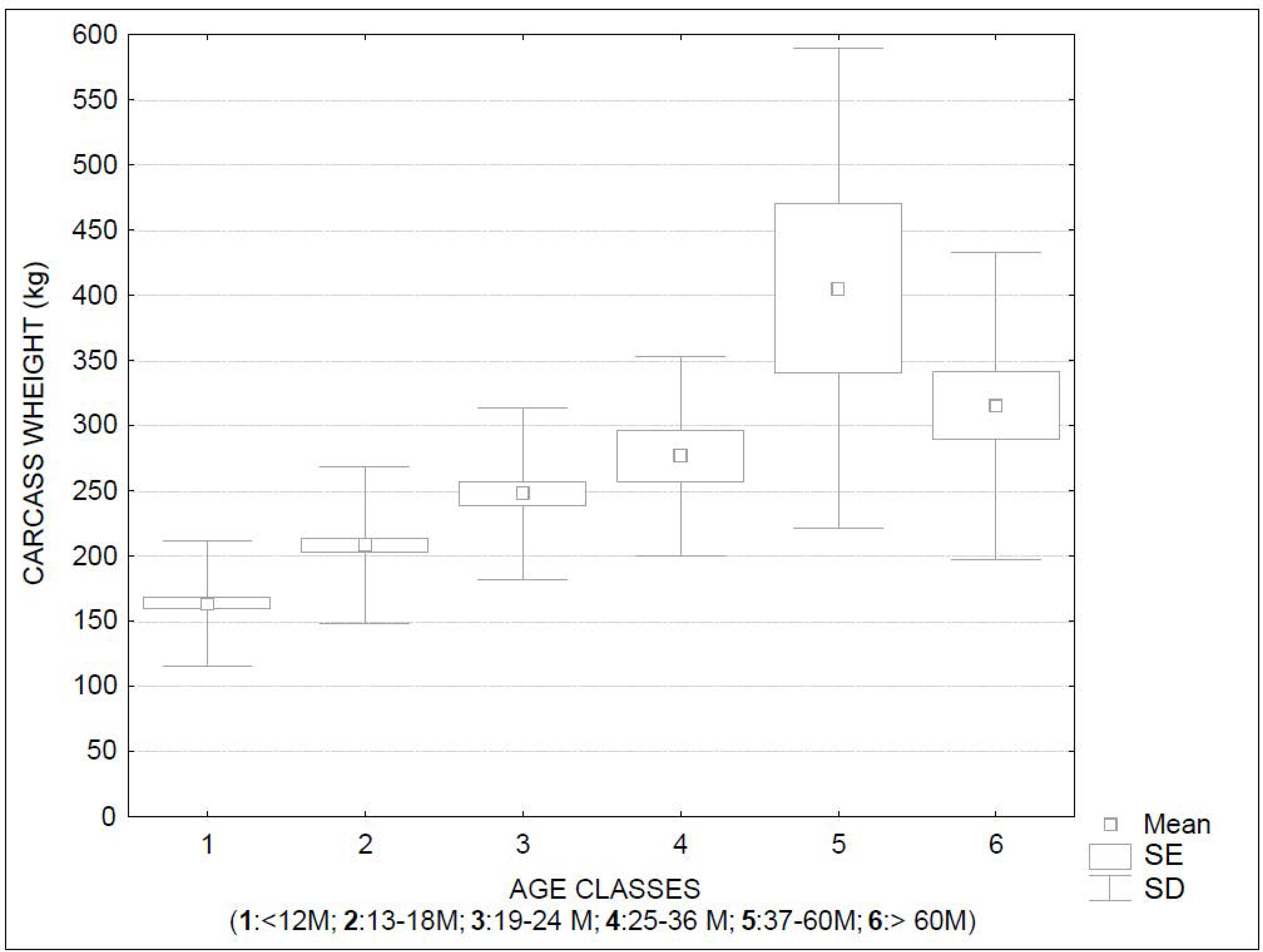Sustainable Local Exploitation and Innovation on Meat Products Based on the Autochthonous Bovine Breed Jarmelista
Abstract
1. Introduction
2. Materials and Methods
3. Results
3.1. Portuguese Agro Biodiversity
3.2. Characterisation of the Territory
3.3. Characterisation of the Production System
4. Discussion
- (i)
- the promotion of genetic preservation and sustainable production of Jarmelista breed;
- (ii)
- the identification of correlations between differentiating characters and biochemical/rheological profile of Jarmelista beef;
- (iii)
- the need to emphasise the importance of biodiversity and territorial sustainability of Jarmelista meat production;
- (iv)
- the development of conditions for the identification of Jarmelista beef as a differentiating element in the production and marketing of meat products;
- (v)
- the need to analyse the strategic positioning of Jarmelista beef in the market;
- (vi)
- the increase in competitiveness in the post-production value chain of Jarmelista beef;
- (vii)
- the development of a strategy that can support the development of Jarmelista beef products in quality records;
- (viii)
- the development of a strategy that makes Jarmelista beef an endogenous product that enhances the economic activity and the region;
- (ix)
- the need to analyse the territorial differentiation factors potentiated by Jarmelista beef;
- (x)
- the need to increase the region’s economic activity (tourism and culture);
- (xi)
- the promotion of cultural interest and culinary essays activities.
5. Conclusions and Implications
Author Contributions
Funding
Institutional Review Board Statement
Informed Consent Statement
Data Availability Statement
Conflicts of Interest
Appendix A. Survey of Cattle Farms of the Jarmelista Breed
- Farm name: _____________________________________________________
- Location of the farm: _____________
- What weight does the production of Jarmelista cattle have on cattle sales?
- ○
- <25%
- ○
- [25:50]%
- ○
- [51:75]%
- ○
- >75%
- Indicate the allocation of the area of your holding to the different activities:
| Area (ha) | |
| Total surface area | |
| Used Agricultural Area (UAS) | |
| Pastures | |
| Annual crops for livestock |
- 5.
- Indicate the actual number of animals on your farm:
| Number of Animals Jarmelista Breed/Other Breeds | |
| Calves up to 6 months | |
| Male calves from 6 to 12 months | |
| Females calves from 6 to 12 months | |
| Steers from 12 to 24 months | |
| Heifers from 12 to 24 months | |
| Bulls | |
| Cows |
- 6.
- Indicate, for the last year of production:
| Animals | Number of Animals Jarmelista Breed/Other Breeds | |||
| Number of Animals | Date | Post-Weaning Feed to Slaughter | ||
| Young | Born | |||
| Weaned | ||||
| Adults | Replacement | |||
| Scrap | ||||
| Dead | At Birth | |||
| Young | ||||
| Adults | ||||
- 7.
- Indicate the results of reproductive management for Jarmelista breed
| Average age at 1st Delivery | |
| Average interval between Deliveries (only for the last delivery) | |
| Average Interval between Total Deliveries |
- 8.
- Feed characterization. Please indicate the main types of feeds used in the farm (e.g., grazing; straw; commercial feed; fodder; other)
- 9.
- Farm Characterization
| Alive | For Slaughter | |
| Number of total animals sold | ||
| Total number of Jarmelista animals sold | ||
| Total volume of animal sales | ||
| Sales volume of Jarmelista animals |
| X = (L + Ne + 0.5D)/3 | Points |
| X = 1.08 = (2 + 0 + 0.5*(1+0.5+0.5+0+0+0.5))/3 | |
| X—risk status; | |
| L—total number of females; | |
| Ne—effective population size; | |
| D—sum of additional elements (sub-factors). | |
| The final score, results in risk status assessment, is as follows: ≤1—critical; > 1 and ≤2—an endangered breed requiring action; > 2 and <3—an endangered breed requiring monitoring; ≥ 3—not at risk. | |
| Components of additional factor 3 (from D1 to D6), were scored as 1, 0.5 or 0. As the assessment of these components was subjective, this factor was weighted as 1/2 to reduce its effect on the end result, and to decrease the estimation error. | |
| L = 1 < 150 females | |
| L = 2150–1000 females | 2 |
| L = 3 > 7500 females | |
| L = 4 > 25000 females | |
| Effective population size: Ne = 4 NMNF/(NM + NF) | |
| NM = the number of males | |
| NF = the number of females | |
| Effective population size is a key parameter for describing genetic diversity in animal populations and predicting rate of inbreeding. Correction to random selection of males and females for mating was applied based on Santiago and Caballero (1995), where: Ne = original Ne × 0.7. The following thresholds were adopted: Ne ≤ 50—0 points, critical status; 50<Ne ≤ 200;—1-point, endangered breed in need of conservation; 200 < Ne ≤ 1000;—2 points, endangered breed in need of monitoring, and Ne > 1000—3 points, non-endangered. It was also assumed that regardless of the final score, if Ne ≤ 50, a breed is considered endangered and in need of conservation, as there is a direct and inversely proportional relationship between the effective population size and the rate of inbreeding. Ne = (4*10*161)/(10 + 161)*0,7 = 26.36 | 0 |
| D1—geographical concentration in a country. We adopted after Alderson (2010), a score scale where 1 point was awarded when ≥75% of the population was concentrated in the region of origin, 0 if only ≤25% of the breed occurred in the region of origin, 0.5 points if the breed concentration was intermediate. Where the population occurred in a small number of herds (≤2), regardless of the end results, the breed was considered endangered and in need of conservation. | 1 |
| D2—the demographic trend over the last 5 years. This is an important and objective factor indicative of the population’s development. Three scores were awarded: 1 point—upward trend; 0.5—stable trend; and 0—downward trend. | 0.5 |
| D3—the cultural value of a breed (documented links with tradition, culture, and the region): 1 point—has cultural/historical value; 0.5—little cultural/historical value; 0—no cultural/historical values. Points awarded by experts of the species-specific Working Groups—that serve as advisory bodies to the National Research Institute of Animal Production. Some breeds have been present in Poland for centuries and are an important part of the country’s cultural heritage. The value of the breed was assessed on the basis of specific elements, such as it being used locally directly or indirectly in contributing to handicraft, folklore, artistic expression, and religious traditions, it being used in local gastronomy and products, and any roles provided in maintaining a specific landscape. The scoring was as follows: 1 point—no cultural/historical value; 0.5—little cultural/historical value; 0—has cultural/historical value. | 0.5 |
| D4—parentage control: 1 point—present; 0.5 –present to a small extent; 0—absent | 0 |
| D5—ex situ conservation: 1 point—present; 0.5—present to a small extent; 0—absent | 0 |
| D6—anthropogenic factors, assessed by experts and on the basis of age of breeders, their activity in implementation of existing conservation programmes (e.g., participation in exhibitions, popularization of breeds and their products, collaboration with breeding organizations), and possibility of financial support for breed conservation: 1 point—anthropogenic factors present; 0.5—partly present; 0—absent. | 0.5 |
References
- McCracken, D.I.; Huband, S. Nature conservation value of European mountain farming systems. In Global Change and Mountain Regions; Springer: Berlin/Heidelberg, Germany, 2005; pp. 573–582. [Google Scholar]
- Sayadi, S.; González-Roa, M.C.; Calatrava-Requena, J. Public preferences for landscape features: The case of agricultural landscape in mountainous Mediterranean areas. Land Use Policy 2009, 26, 334–344. [Google Scholar] [CrossRef]
- Navarro, L.M.; Pereira, H.M. Rewilding abandoned landscapes in Europe. In Rewilding European Landscapes; Springer: Cham, Switzerland, 2015; pp. 3–23. [Google Scholar]
- Ruiz-Mirazo, J.; Robles, A.B.; González-Rebollar, J.L. Two-year evaluation of fuelbreaks grazed by livestock in the wildfire prevention program in Andalusia (Spain). Agric. Ecosyst. Environ. 2011, 141, 13–22. [Google Scholar] [CrossRef]
- Albuquerque, T.G.; Oliveira, M.B.P.; Costa, H.S. 25 years of European Union (EU) quality schemes for agricultural products and foodstuffs across EU Member States. J. Sci. Food Agric. 2018, 98, 2475–2489. [Google Scholar] [CrossRef] [PubMed]
- Smith, C.S.; McDonald, G.T. Assessing the sustainability of agriculture at the planning stage. J. Environ. Manag. 1998, 52, 15–37. [Google Scholar] [CrossRef]
- Altieri, M.A. Linking Ecologists and Traditional Farmers in the Search for Sustainable Agriculture. Front. Ecol. Environ. 2004, 2, 35. [Google Scholar] [CrossRef]
- Hansen, J.W. Is agricultural sustainability a useful concept? Agric. Syst. 1996, 50, 117–143. [Google Scholar] [CrossRef]
- Masera, O.; Astier, M.; López-Ridaura, S. El marco de evaluación MESMIS. In Sustentabilidad y Sistemas Campesinos. Cinco Experiencias de Evaluación en el México Rural. Omar M. y S. López-Ridaura (eds.); GIRA AC/Mundi-Prensa/PUMA: Pátzcuaro, Michoacán, Mexico, 2000. [Google Scholar]
- FAO. The State of Food and Agriculture 2019. In Moving forward on Food Loss and Waste Reduction; FAO: Rome, Italy, 2019; Licence: CC BY-NC-SA 3.0 IGO. [Google Scholar]
- De Barcellos, M.D.; Kügler, J.O.; Grunert, K.G.; Van Wezemael, L.; Pérez-Cueto, F.J.; Ueland, Ø.; Verbeke, W. European consumers’ acceptance of beef processing technologies: A focus group study. Innov. Food Sci. Emerg. Technol. 2010, 11, 721–732. [Google Scholar] [CrossRef]
- Van Wezemael, L.; Verbeke, W.; Kügler, J.O.; Scholderer, J. European consumer acceptance of safety-improving interventions in the beef chain. Food Control 2011, 22, 1776–1784. [Google Scholar] [CrossRef]
- Schleenbecker, R.; Hamm, U. Consumers’ perception of organic product characteristics. A review. Appetite 2013, 71, 420–429. [Google Scholar] [CrossRef] [PubMed]
- Willer, H.; Schlatter, B.; Trávníček, J.; Kemper, L.; Lernoud, J. The World of Organic Agriculture. Statistics and Emerging Trends 2020; Research Institute of Organic Agriculture (FiBL): Frick, Switzerland, 2020. [Google Scholar]
- Willer, H.; Lernoud, J.; Kilcher, L. The world of organic agriculture. Stat. Emerg. Trends 2011, 11, 26–32. [Google Scholar]
- Cruz, M. Comportamento e Perfil do Consumidor de Alimentos Biológicos em Portugal; ISA/UTL: Lisbon, Portugal, 2011. [Google Scholar]
- DGADR. Diário da República, 1.a Série-N.o 144-27 de julho de 2017. In Diário da República; DGADR: Lisbon, Portugal, 2017. [Google Scholar]
- Monteiro, A.C.G.; Fontes, M.A.; Bessa, R.J.B.; Prates, J.A.M.; Lemos, J.P.C. Intramuscular lipids of Mertolenga-PDO beef, Mertolenga-PDO veal and “Vitela Tradicional do Montado”-PGI veal. Food Chem. 2012, 132, 1486–1494. [Google Scholar] [CrossRef] [PubMed]
- Monteiro, A.C.G.; Santos-Silva, J.; Bessa, R.J.B.; Navas, D.R.; Lemos, J.P.C. Fatty acid composition of intramuscular fat of bulls and steers. Livest. Sci. 2006, 99, 13–19. [Google Scholar] [CrossRef]
- Araújo, J.; Cerqueira, J.; Vaz, P.; Andrade, L.; Rodrigues, J.; Rodrigues, A. Extensive beef cattle production in Portugal. In Proceedings of the International Worskshop New Updates in Animal Nutrition, Natural Feeding Sources and Environmental Sustainability, Arzachena, Italy, 5–6 May 2014; pp. 31–44. [Google Scholar]
- Schirpke, U.; Kohler, M.; Leitinger, G.; Fontana, V.; Tasser, E.; Tappeiner, U. Future impacts of changing land-use and climate on ecosystem services of mountain grassland and their resilience. Ecosyst. Serv. 2019, 26 Pt A, 79–94. [Google Scholar] [CrossRef] [PubMed]
- Malagueira, R.J.P. Caracterização Genética por Análise Demográfica da Raça Bovina Jarmelista; Instituto Politécnico de Santarém: Santarém, Portugal, 2018. [Google Scholar]
- INE. Recenseamento Agrícola-Análise dos Principais Resultados: 2009; Instituto Nacional de Estatística: Lisbon Portugal, 2017. [Google Scholar]
- Costa, M. As Bases Biológicas Das Produções Animais, Volume II, B–Produção de Carne; Instituto Superior de Agronomia: Lisbon, Portugal, 2004. [Google Scholar]
- EUROSTAT, n.d.a. Eurostat Statistics Database: Statistics Explained-Agricultural census in Portugal. Available online: https://ec.europa.eu/eurostat/statistics-explained/index.php?title=Archive:Agricultural_census_in_Portugal (accessed on 5 January 2021).
- GPP. Gabinete de Planeamento, Políticas e Administração Geral; Carne: Diagnóstico Sectorial; Ministério da Agricultura, do Desenvolvimento Rural e das Pescas: Lisbon, Portugal, 2006.
- GPP. Gabinete de Planeamento, Políticas e Administração Geral; Informação sobre Produtos-Dados Estatísticos; Ministério da Agricultura, do Mar, do Ambiente e do Ordenamento do Território: Lisbon, Portugal, 2020.
- Ralo, J. Conservation and Defence of the Genetic Heritage of Autochthonous Bovines in Portugal. Vida Rural 1990, 20, 12–15. [Google Scholar]
- Francisco, M. Efeito do genótipo na qualidade da carne de bovinos. In Relatório de Trabalho de Fim de Curso de Engenharia Agronómica; Instituto Superior de Agronomia, Universidade Técnica de Lisboa: Lisboa, Portugal, 2004. [Google Scholar]
- GPP. Gabinete de Planeamento, Políticas e Administração Geral; Informação de Mercados-Produtos Animais; Ministério da Agricultura, Florestas, Desenvolvimento Rural e do Mar: Lisbon, Portugal, 2017.
- Santos, C. A procura da carne em Portugal. In Estudos e Documentos; GPPAA-Gabinete de Planeamento e Política Agro-Alimentar, Ministério da Agricultura, do Desenvolvimento Rural e das Pescas: Lisboa, Portugal, 2000. [Google Scholar]
- Dgv, D.; INIA/EZN; ACRIGUARDA. Caracterização Morfológica da População Bovina Jarmelista; Ministério da Agricultura, do Desenvolvimento Rural e das Pescas: Lisbon, Portugal, 2006.
- Gomes, A.; Almeida, V. O Distrito da Guarda em Números; Comissão de Coordenação e Desenvolvimento Regional do Centro-CCDRC: Coimbra, Portugal, 2010. [Google Scholar]
- Tavares, R.C.C. Pastagens de Altitude: Caracterização de Uma Exploração na Região da Guarda; ISA/UL: Lisbon, Portugal, 2014. [Google Scholar]
- Coelho, P.M.F.V. Pastagens de Altitude. Caracterização e Melhoramento. Pastagens Semeadas na Região da Guarda; ISA-UL: Lisbon, Portugal, 2016. [Google Scholar]
- Moreira, N. Agronomia das Forragens e Pastagens; Universidade de Tras-os-Montes e Alto Douro: Vila Real, Portugal, 2002. [Google Scholar]
- Parreira, A. Influência do Meio Ambiente e de Algumas Técnicas Culturais nas Produções Pratense e Forrageira; Prova de aptidão e capacidade cientifica, Instituto Superior de Agronomia: Lisbon, Portugal, 1985. [Google Scholar]
- Piedrafita, J.; Quintanilla, R.; Sañudo, C.; Olleta, J.-L.; Campo, M.a.-M.; Panea, B.; Renand, G.; Turin, F.; Jabet, S.; Osoro, K. Carcass quality of 10 beef cattle breeds of the Southwest of Europe in their typical production systems. Livest. Prod. Sci. 2003, 82, 1–13. [Google Scholar] [CrossRef]
- Polak, G.; Krupiński, J.; Martyniuk, E.; Calik, J.; Kawęcka, A.; Krawczyk, J.; Majewska, A.; Sikora, J.; Sosin-Bzducha, E.; Szyndler-Nędza, M. The risk status of polish local breeds under conservation programmes-new approach. Ann. Anim. Sci. 2020. [Google Scholar] [CrossRef]
- Presumido, P.H.; Sousa, F.; Gonçalves, A.; Bosco, T.C.D.; Feliciano, M. Environmental Impacts of the Beef Production Chain in the Northeast of Portugal Using Life Cycle Assessment. Agriculture 2018, 8, 165. [Google Scholar] [CrossRef]
- FAO. The Second Report on the State of the World’s Animal Genetic Resources for Food and Agriculture; FAO Commission on Genetic Resources for Food and Agriculture Assessments: Rome, Italy, 2015. [Google Scholar]
- Boudalia, S.; Ben Said, S.; Tsiokos, D.; Bousbia, A.; Gueroui, Y.; Mohamed-Brahmi, A.; Smeti, S.; Anastasiadou, M.; Symeon, G. BOVISOL Project: Breeding and Management Practices of Indigenous Bovine Breeds: Solutions towards a Sustainable Future. Sustainability 2020, 12, 9891. [Google Scholar] [CrossRef]
- Gandini, G.; Ollivier, L.; Danell, B.; Distl, O.; Georgoudis, A.; Groeneveld, E.; Martyniuk, E.; Van Arendonk, J.; Woolliams, J. Criteria to assess the degree of endangerment of livestock breeds in Europe. Livest. Prod. Sci. 2004, 91, 173–182. [Google Scholar] [CrossRef]
- Marsoner, T.; Vigl, L.E.; Manck, F.; Jaritz, G.; Tappeiner, U.; Tasser, E. Indigenous livestock breeds as indicators for cultural ecosystem services: A spatial analysis within the Alpine Space. Ecol. Indic. 2018, 94, 55–63. [Google Scholar] [CrossRef]
- Garcia-Oliveira, P.; Fraga-Corral, M.; Pereira, A.G.; Prieto, M.A.; Simal-Gandara, J. Solutions for the sustainability of the food production and consumption system. Crit. Rev. Food Sci. Nutr. 2020, 1–17. [Google Scholar] [CrossRef] [PubMed]
- Alderighi, M.; Bianchi, C.; Lorenzini, E. The impact of local food specialities on the decision to (re)visit a tourist destination: Market-expanding or business-stealing? Tour. Manag. 2016, 57, 323–333. [Google Scholar] [CrossRef]
- Simoncini, R. Introducing territorial and historical contexts and critical thresholds in the analysis of conservation of agro-biodiversity by Alternative Food Networks, in Tuscany, Italy. Land Use Policy 2015, 42, 355–366. [Google Scholar] [CrossRef]
- Gicquel, E.; Boettcher, P.; Besbes, B.; Furre, S.; Fernandez, J.; Danchin-Burge, C.; Berger, B.; Baumung, R.; Feijoo, J.R.J.; Leroy, G. Impact of conservation measures on demography and genetic variability of livestock breeds. Animal 2020, 14, 670–680. [Google Scholar] [CrossRef] [PubMed]
- Sartorello, Y.; Pastorino, A.; Bogliani, G.; Ghidotti, S.; Viterbi, R.; Cerrato, C. The impact of pastoral activities on animal biodiversity in Europe: A systematic review and meta-analysis. J. Nat. Conserv. 2020, 56, 125863. [Google Scholar] [CrossRef]
- Bernués, A.; Ruiz, R.; Olaizola, A.; Villalba, D.; Casasús, I. Sustainability of pasture-based livestock farming systems in the European Mediterranean context: Synergies and trade-offs. Livest. Sci. 2011, 139, 44–57. [Google Scholar] [CrossRef]
- Hoffmann, I. Adaptation to climate change–exploring the potential of locally adapted breeds. Animal 2013, 7, 346–362. [Google Scholar] [CrossRef] [PubMed]
- Meier, C.; Oehen, B. Consumers’ Valuation of Farmers’ Varieties for Food System Diversity. Sustainability 2019, 11, 7134. [Google Scholar] [CrossRef]
- Resano, H.; Sanjuán, A.I. Exploring the role of mountain origin and autochthonous breed on urban consumers’ acceptability. Sustainability 2018, 10, 4423. [Google Scholar] [CrossRef]
- Novaković, B.; Grujić, R.; Vujadinović, D. Value chain analysis for meat and meat products. J. Hyg. Eng. Des. 2015, 12, 93–102. [Google Scholar]
- Genovese, D.; Culasso, F.; Giacosa, E.; Battaglini, L.M. Can livestock farming and tourism coexist in mountain regions? A new business model for sustainability. Sustainability 2017, 9, 2021. [Google Scholar] [CrossRef]





| Producer | Feeds Used | |||||
|---|---|---|---|---|---|---|
| Grazing | Hay | Straw | Commercial Feed | Oat/Rye Fodder | Herb Fodder | |
| 1 | X | X | X | |||
| 2 | X | X | X | |||
| 3 | X | X | X | |||
| 4 | X | X | X | |||
| 5 | X | X | X | |||
| 6 | X | X | X | |||
| 7 | X | X | X | |||
| 8 | X | X | ||||
| 9 | X | X | X | |||
| 10 | X | X | X | |||
| 11 | X | X | X | |||
| 12 | X | X | X | X | ||
| 13 | X | X | X | |||
| 14 | X | X | X | X | ||
| 15 | X | X | X | |||
| 16 | X | X | X | |||
| 17 | X | X | X | |||
| 18 | X | X | X | |||
| 19 | X | |||||
| 20 | X | |||||
| % Usage | 85 | 75 | 70 | 40 | 10 | 5 |
| Age at 1st Delivery (Months) | Interval between Deliveries (Days) | Fertility Rate | Age of Registered Females (Years) | Age of Registered Males (Years) | |
|---|---|---|---|---|---|
| Average ± SD | 38.32 ± 10.36 | 440.28 ± 57.43 | 84.22 ± 10.42 | 6.6 ± 1.77 | 2.6 ± 2.18 |
| Age Class | Weight (kg) | Sex | Conformation Grade | ||||||
|---|---|---|---|---|---|---|---|---|---|
| E | U | R | O | P | TOTAL | ||||
| 1 | <12 M | 163.64 ± 47.9 | F | 9 | 22 | 31 | |||
| M | 18 | 30 | 48 | ||||||
| 2 | 13–18 M | 208.28 ± 60.1 | F | 0 | 8 | 39 | 0 | 47 | |
| M | 2 | 34 | 49 | 1 | 86 | ||||
| 3 | 19–24 M | 247.65 ± 66.2 | F | 1 | 5 | 1 | 7 | ||
| M | 1 | 4 | 13 | 24 | 0 | 42 | |||
| 4 | 25–36 M | 276.71 ± 76.3 | F | 0 | 2 | 3 | 1 | 6 | |
| M | 1 | 3 | 5 | 0 | 9 | ||||
| 5 | 37–60 M | 405.46 ± 184.0 | F | 0 | 0 | 0 | 5 | 15 | 20 |
| M | 5 | 5 | 10 | 0 | 0 | 20 | |||
| 6 | >60 M | 306.54 ± 122.0 | F | 0 | 0 | 0 | 12 | 4 | 16 |
| M | 1 | 1 | 1 | 2 | 1 | 6 | |||
| TOTAL | 7 | 13 | 99 | 196 | 23 | 338 | |||
| Ecological | Social | Cultural | Economic | |
|---|---|---|---|---|
| Positive aspects | Characteristics and versatility of animals | Fixing population in rural areas | Preservation of an autochthonous breed | Improving business competitiveness of Jarmelista meat production |
| Production system | Improving population identity | Preservation of traditional production methods | Improving market satisfaction | |
| Biodiversity preservation of the territory | Preservation of territory’s landscape | Meat is an appreciated cultural product of the Portuguese diet | Enhancing new business creation in tourism and restauration sector | |
| Better response to consumer ecological concerns | Enhancing traditional cuisine | |||
| Consumers interest in alternative, less intensive, forms of production. | ||||
| Negative aspects | Ecological arguments for not sufficient eco achievements of meat production | Low population density area | Difficulties in cultural and traditional proud arguments | Business knowledge capacity |
| Low ecological education and knowledge | Typical difficulty for farmers association in the country | Marketing perspective adoption | ||
| Low economic capacity | ||||
| Consumer willingness to pay for quality products |
Publisher’s Note: MDPI stays neutral with regard to jurisdictional claims in published maps and institutional affiliations. |
© 2021 by the authors. Licensee MDPI, Basel, Switzerland. This article is an open access article distributed under the terms and conditions of the Creative Commons Attribution (CC BY) license (http://creativecommons.org/licenses/by/4.0/).
Share and Cite
Coutinho, P.; Simões, M.; Pereira, C.; Paiva, T. Sustainable Local Exploitation and Innovation on Meat Products Based on the Autochthonous Bovine Breed Jarmelista. Sustainability 2021, 13, 2515. https://doi.org/10.3390/su13052515
Coutinho P, Simões M, Pereira C, Paiva T. Sustainable Local Exploitation and Innovation on Meat Products Based on the Autochthonous Bovine Breed Jarmelista. Sustainability. 2021; 13(5):2515. https://doi.org/10.3390/su13052515
Chicago/Turabian StyleCoutinho, Paula, Manuel Simões, Carlos Pereira, and Teresa Paiva. 2021. "Sustainable Local Exploitation and Innovation on Meat Products Based on the Autochthonous Bovine Breed Jarmelista" Sustainability 13, no. 5: 2515. https://doi.org/10.3390/su13052515
APA StyleCoutinho, P., Simões, M., Pereira, C., & Paiva, T. (2021). Sustainable Local Exploitation and Innovation on Meat Products Based on the Autochthonous Bovine Breed Jarmelista. Sustainability, 13(5), 2515. https://doi.org/10.3390/su13052515








